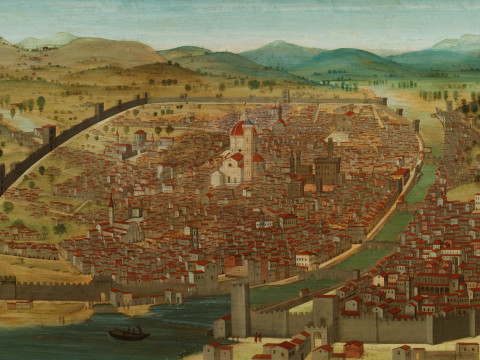
John Constable's last decade
By Alexandra Harris
Published on 26 October 2021
Constable didn't know he was entering his ‘late’ period, but in the last ten years of his life he sought truth in nature, and created landscapes infused with timeless imagination.
Alexandra Harris is author of Romantic Moderns and Weatherland (both Thames & Hudson) and Professor of English at Birmingham University.
Wordsworth was there in the audience at the Royal Institution when Constable gave one of his last lectures on landscape in 1836. Constable wrote to the poet afterwards with respect and affection, and sent a book of engravings made after his pictures. They didn’t know each other well, but they were bound together by common love and loss of a dear friend, the art collector George Beaumont, and had long been following each other’s explorations of memory, return and associative emotion.
The book of prints, Constable explained with bleak economy, had occupied him “during a season of Sadness occasioned by the loss of the mother of my seven children”. He called it a “little work” but Various Subjects of Landscape, Characteristic of English Scenery (1830-32) was a major project on which he had collaborated for years with his chosen engraver David Lucas (preparatory proof Vignette: Hampstead Heath, Middlesex, 1829; below).
It was about the eternal conversation between darkness and light, “the chiaro-oscuro of nature” as he called it, which for Constable was inseparable from the chiaroscuro of human experience. It was one of many works of intense conviction to emerge from an extended “season of Sadness” that was also, inspiringly, a season of friendship, tribute and discovery.

Late Constable at the Royal Academy is set to draw us into the mixed weathers and complicated feelings of the artist’s final decade. There will be no easy equation of storms with sorrow and sunbursts with resolution; the evanescent rainbows that arc over anonymous backwaters of the Stour, and over Salisbury Cathedral and Stonehenge will suggest to viewers as many refracting thoughts as the long-faded crayon rainbows remembered in little Blu Tack smears still marking our front windows.
Constable didn’t get much chance at lateness. He was taken ill suddenly one spring night in 1837 at the age of 60. He was in the midst of things: lecturing, teaching at the Royal Academy Schools, finishing a large-scale picture.
Despite grief and fragile health, and all his responsibilities as a single parent, his achievement in his 50s had been extraordinary. Official recognition had been slow in coming, but once elected as a Royal Academician in 1829 he involved himself tirelessly, wanting to shape the direction of British art. At last he had a platform and he used it, arguing for the seriousness of landscape art and the experimental possibilities in studying nature. He did not know this was his ‘late’ period, he was not narrating his ending, but he was conscious of gathering and presenting his discoveries – in the mezzotints he sent to Wordsworth, in lectures, improvisatory sketchbooks and each giant picture completed (and then reworked some more) for the annual Royal Academy exhibitions: The Cornfield (1826), The Vale of Dedham (1828), Hadleigh Castle (1828-29), The Valley Farm (1835).
Constable's darkness was always defined by light – sunlight behind storm clouds, the light he set in motion across the surface of his pictures like foam riding on waves...
A succession of personal losses made him feel belated, as if he were the last watcher still awake as night drew on. “The world is left to darkness and to me,” he wrote in 1833, quoting Thomas Gray’s Elegy Written in a Country Churchyard, for which he was making a series of illustrations.
Yet his darkness was always defined by light – sunlight behind storm clouds, the light he set in motion across the surface of his pictures like foam riding on waves or else like an electric charge, and which came to be known as ‘Constable’s snow’.
He pressed ahead by looking back. Again and again he retrieved sketches from decades before and made them the prompt for new work. Sometimes he repeated an earlier composition, as if asking “What is it to me now, this scene?” and “What will I make of it, after all that has happened?”
Critics in search of the immediacy and “truth to nature” that gleam from Flatford Mill (1816-17) and other pictures of the 1810s have not always enthused about Constable’s more allusive and layered later style. They’re right to find the artist less freshly particular about riverside plants and the materials of Willy Lott’s cottage.

Why was Constable so often referring back to sketches or earlier paintings when he had such a gift for capturing the living world around him? The RA exhibition will show, I think, that he was gripped by a new project, another kind of questioning. Distance and time were at the heart of it. He was as committed as ever to his old subjects. He still loved “the sound of water escaping from mill-dams… willows, old rotten planks, slimy posts and brickwork”, and he held true to his faithful promise: “As long as I do paint I shall never cease to paint such Places.” But his subject was also, now, the way that such places live in the mind, and live in art. Sometimes he seems to paint the workings of memory itself.
The simple building in A Cottage at East Bergholt (c.1833), or the boatmen in the flickering light of A Farmhouse near the Water’s Edge (‘On the Stour’) (c.1834-36; below), are glimpsed through air that vibrates with fiercely controlled energy. The wind that moves over the water and through the trees is not quite nature’s wind (though you can almost feel it on your face) but an imaginative force field. The glint and glimmer, the tension and passion of these atmospheres has never grown old. For Lucian Freud, they were a defining influence. Leon Kossoff made etchings and drawings after Constable in the 1980s, as if conducting lightning or plugging into a current that the 19th-century pictures were still emitting.
“Constable has meant more and more and more to me,” Frank Auerbach observed in 2014, wondering at the slow-release intensity of pictures in which “everything has been worked for and made personal”. Constable’s rapid brush marks suggest the urgency of catching something liable to dissolve at any moment. He worked over and over the same small areas, until paint seemed to build like geological strata. There are parallel timescales at work, conveying the sensations of a moment (a gust of wind, a rush of feeling) and a dense accumulation of looking and remembering.

Many, perhaps most, of us live apart from places of great significance to us. They come with us through our lives, changing as we change until “the picture of the mind revives again”, as Wordsworth put it, returning to Tintern after many years. Wordsworth consciously saved up certain views as “life and food / For future years”.
Constable, in London, revived pictures he had laid down over decades in his sketchbooks. He became a great artist of commemoration. “I am almost daily bereft of some friend or other,” he wrote in sorrow; he thought intently about how his paintings might register absence, and recall presence. Perhaps this is brought to the fore by the shadowiness of our own times, and our sense of gratitude to friends and communities. It seems to me now that Constable’s work breathes with the love of others. It is made from friendships, from recollection of care and company, and from respect for other artists.
The large picture Constable finished for exhibition in 1836 was something very different from his mills and open fields; those looking for versions of The Hay Wain (1821) might turn in puzzlement from the eerie, formal, forested Cenotaph to the Memory of Sir Joshua Reynolds (1833-36). Look back and life is there – in the branching of the lime trees, the flickering, dance-like movement of the deer. Layers of tribute are woven together: to Reynolds, whose advocacy of British painting was a powerful model for Constable in ways we might not have predicted, and also to Beaumont, who had installed this memorial in his grounds at Coleorton Hall in Leicestershire. Constable said he wanted to see the names of Reynolds and Beaumont together once more in the Academy catalogue. His own name of course stood beside them, and so did the words composed by Wordsworth for the cenotaph. Haunted, brimming, ripe with recollection, Constable was convening a gathering.
Constable’s work breathes with the love of others. It is made from friendships, from recollection of care and company, and from respect for other artists.
The 1830s brought the discovery of a landscape that promised to be a heartening new subject. Two summers running he took the children down to Arundel in Sussex to stay with a friend who was a brewer in the town. The mills, willows and water meadows of the Arun Valley, so reminiscent of the Stour and so different, worked on his imagination. “I never saw such beauty in natural landscape before,” he enthused; “I prefer it to any other for my pictures.” His Sussex work was less fraught than his returns to long-remembered places; the sketches have about them a luminous delicacy.
In London on 31 March 1837 Constable ate dinner and settled to his bedtime book. It was the new biography of William Cowper, a poet who, 50 years earlier, had insisted against all odds on his domestic surroundings in Buckinghamshire as the epic subject of his writing, exploring the strength of personal attachment to familiar scenes.
Constable, an inheritor of Cowper, had fought all his life for the right to hang his pictures of rural England in London’s halls of cultural fame. His art was “to be found under every hedge, and in every lane”, he said, and it was now also to be found in gilded rooms on the Strand, ousting the painted kings and satyrs generally deemed more worthy of attention. He had much more still to do. So he read himself to sleep with Cowper’s hares, Cowper’s daily walks.
He woke in pain later that night. It was probably a heart attack; he died the following day. Arundel Mill and Castle (1837; above) was all but finished when death interrupted. It was a classically Claudean composition announcing the grandeur of its subject (an English river, a downland hanger), but it was also rich with the observed textures of a known place.
Visitors to Arundel usually focus their attentions on the castle, but Constable pushed the landmark building into the background and made it an outcrop from the hillside. “All here sinks to insignificance in comparison with the woods, and hills,” he wrote. He took the lane out of town, sat himself by Swanbourne Lake and made the mill his alternative castle – celebrating as he always had the vernacular brick and wood of a working place. He put in two boys fishing; he let trees dominate it all. The painted surface deepened and intensified as he worked over and over it. Time seems to pool and swell like water behind a millpond sluice. Introducing his “little” set of mezzotints, Constable had quoted Wordsworth on the artist’s effort to make permanent “one brief moment caught from fleeting time”. In his last picture, brevity and permanence move together through every tree. A life’s looking and thinking is held on the canvas – as well as the chiaroscuro of a summer afternoon.


Enjoyed this article?
As well as free entry to all of our exhibitions, Friends of the RA enjoy one of Britain’s most respected art magazines, delivered directly to your door. Why not join the club?
Related articles

The great art quiz of 2024
18 December 2024

A love letter to the gallery gift shop
18 November 2024

Painting the town: Florence in 1504
15 November 2024